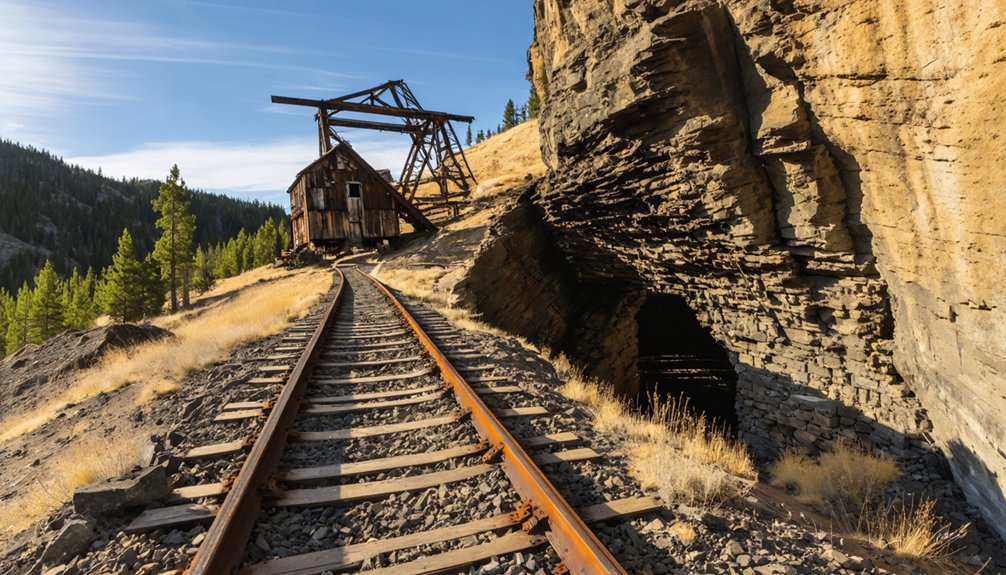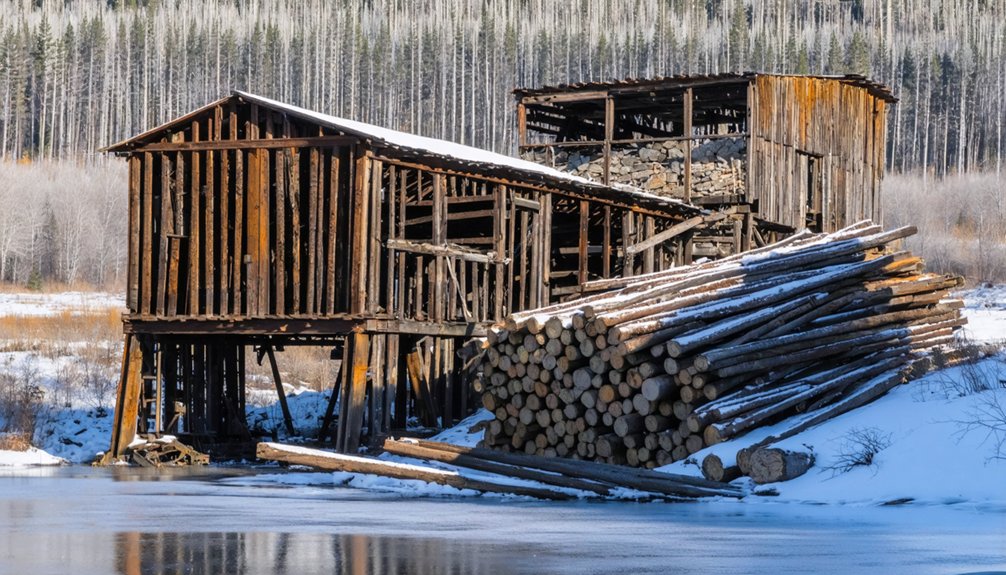You’ll find Marshall Lake ghost town nestled at 7,720 feet in Idaho’s Sawtooth Mountains, accessible via the Alpine Way trail. This former mining settlement centered around the Golden Anchor Mine, which produced $2 million in gold between 1915-1942 before World War II restrictions shut it down. Today, weathered buildings and mining equipment dot the remote landscape, while Williams and Merritt Peaks tower above the abandoned site’s compelling story of boom and bust.
Key Takeaways
- Marshall Lake is a former mining settlement located in Idaho’s Sawtooth Mountains at 7,720 feet elevation, accessible via Alpine Way trail.
- The area thrived during gold mining operations from 1900-1942, with the Golden Anchor Mine producing $2,000,000 in total output.
- World War II restrictions in 1942 forced the closure of mining operations, leading to Marshall Lake’s transformation into a ghost town.
- Visitors can explore weathered structures, abandoned mining equipment, and historic buildings that reflect the area’s mining heritage.
- The site showcases diverse mining history, from hydraulic operations to underground mining, with natural reclamation now taking over structures.
Location and Geographic Features
Nestled within the rugged Sawtooth Mountains of Custer County, Idaho, Marshall Lake stands as a pristine alpine glacial lake within the Sawtooth National Recreation Area.
You’ll find this hidden gem at coordinates 44°09′30″N 114°59′11″W, where scenic views of Williams and Merritt Peaks create a dramatic mountain backdrop.
To reach the lake, you’ll need to navigate the Alpine Way trail (528), which requires a wilderness permit for entry.
Access to Marshall Lake requires following Alpine Way trail (528) and securing the necessary wilderness permit beforehand.
The surrounding Sawtooth Wilderness offers prime opportunities for wildlife observation, though the terrain’s challenging nature means you’ll want to come prepared.
The Stanley Ranger Station serves as your nearest point of contact, and while the journey might test your resolve with rough roads that demand 4WD vehicles, the pristine wilderness setting makes it worth the effort. The area’s beautiful tranquil waters, reminiscent of nearby Redfish Lake, provide an idyllic setting for outdoor enthusiasts. The lake sits at 7,720 feet elevation, offering breathtaking high-altitude views of the surrounding wilderness.
Discovery and Early Mining Days
The discovery of Marshall Lake’s mineral wealth began in the wake of the 1862 Warrens gold strike, as prospectors ventured into the Thunder Mountain area drawn by promising surface mineralization.
Early prospector stories tell of their reliance on seasonal snowmelt for hydraulic mining, giving them just brief windows to work their claims each year.
The area’s first significant development came in 1900 when miners staked the Kimberly Mine, yielding about 35 ounces of gold in its initial phase. Some miners resorted to salting of samples to mislead investors about the richness of their claims.
While mining legends grew around Thunder Mountain’s potential riches, Marshall Lake’s true mining boom wouldn’t arrive until after 1914.
Early miners worked free-milling gold ores using California-type stamp mills and simple sluicing methods.
The region’s development paralleled the growth of Elk City settlement, which had established the first mining camp in Idaho County in 1861.
You’ll find their legacy in the seventeen mining districts that eventually dotted Idaho County, marking an era of rugged determination and mineral pursuit.
Peak Mining Operations (1915-1940)
Marshall Lake’s mining operations hit their stride in 1915 with the establishment of the Golden Anchor mine, which quickly became the area’s central hub and included essential infrastructure like a schoolhouse.
During its peak years from 1916 to 1918, the region yielded an impressive $289,000 in gold production, though miners faced significant technical challenges due to the area’s rugged terrain and harsh climate. The wagon road access provided the only transportation link to the nearest railroad point for moving equipment and ore.
The mine’s operations continued until World War II forced its closure in 1942, despite a brief reopening attempt in 1940 that couldn’t overcome wartime resource constraints. Visitors to the area today can still explore the many original buildings that remain from the Golden Anchor Mine operations.
Initial Mine Development
Mining operations at Marshall Lake gained significant momentum in 1915 when the Golden Anchor Mine commenced full-scale production, marking the beginning of the area’s most prosperous era.
You’ll find this historical mining district emerged from the Thunder Mountain rush, quickly establishing itself as a crucial hub for mineral extraction in Idaho Territory.
- The district’s innovative mining techniques included both placer and deep shaft operations, maximizing ore recovery.
- Production reached impressive levels, eventually totaling $2,000,000 in output.
- The Golden Anchor Mine served as the district headquarters, centralizing operations.
- Mining activities continued steadily until 1942, when World War II forced operations to cease.
This period showcased the evolution of mining methods and technological advancement, cementing Marshall Lake’s historical significance in Idaho’s mining heritage.
Gold Production Challenges
During Marshall Lake’s peak mining period from 1915 to 1940, gold production faced numerous operational hurdles despite yielding an impressive $2 million in total output.
The region’s bedrock contained important deposits of quartzite and gneiss that influenced mining operations throughout the district.
You’ll find that the district’s most productive years occurred between 1916 and 1918, though mining regulations and economic fluctuations frequently disrupted operations.
The challenges you’d encounter included harsh weather conditions and complex geological formations of schist and quartzite that made extraction difficult.
When World War II arrived, you couldn’t continue operations due to the national gold mining shutdown.
A 50 ton mill was constructed to process ore more efficiently in 1940, marking a significant upgrade to the mining operation.
The district’s profitability constantly shifted with gold price changes, while the cost of implementing new mining technologies strained resources.
Mining companies had to adapt their strategies, balancing the need for efficient extraction methods against rising operational costs and environmental considerations.
Wartime Operation Suspensions
Although Marshall Lake’s mining district had weathered earlier challenges, World War II dealt the final blow to its operations in 1942 when federal mandates halted all non-essential gold mining nationwide.
The wartime policies that prioritized strategic metals over gold production would permanently reshape the district’s future.
Here’s what you should know about Marshall Lake’s final chapter:
- The Golden Anchor Mine, operating since 1915, was forced to close in 1942 due to strict mining regulations.
- Mining operations had generated approximately $2,000,000 in gold production before the shutdown.
- The last significant production phase occurred from 1935 to 1942.
- Despite attempts to revitalize operations in 1938 through Salt Lake investors, the wartime suspension proved insurmountable.
This closure accelerated Marshall Lake’s shift to ghost town status, marking the end of its mining era.
World War II Impact and Decline

While Marshall Lake’s mining operations had thrived through the 1930s, the federal government’s wartime restrictions on non-essential mining during World War II dealt a severe blow to local production.
You’ll find that these restrictions, coupled with wartime labor shortages and resource rationing, effectively halted most mining activity in the area by 1943. During that same year, a B-23 Dragon Bomber crashed near McCall during treacherous winter conditions, highlighting the region’s challenging terrain. All eight crewmen survived the incident despite the harsh winter weather and remote location.
The post-war period brought no relief, as rising operational costs and depleted ore deposits made it impossible for the mines to resume profitable operations, leading to their permanent closure.
Wartime Mining Restrictions
As World War II intensified in 1942, the U.S. War Production Board imposed Order L-208, forcing gold mines nationwide to shut down. This sweeping regulation hit Marshall Lake’s Golden Anchor Mine hard, leading to its permanent closure that same year.
The government’s strict mining regulations redirected labor and resources toward strategic minerals needed for the war effort.
The impact on mining operations was severe:
- Workers were diverted to essential war-related mining, creating widespread labor shortages
- Critical materials like steel, explosives, and fuel were strictly restricted
- Only mines producing strategic minerals like tungsten and antimony received exemptions
- Maintaining closed mines proved too costly, with many suffering infrastructure damage
You’ll find that Marshall Lake’s mining district, once thriving with gold production, couldn’t survive these wartime restrictions and never recovered.
Post-War Production Struggles
Despite the end of World War II in 1945, Marshall Lake’s mining operations faced insurmountable challenges that prevented their revival.
You’d find that severe labor shortages plagued the district, as former miners had moved on to more stable industries during the war and didn’t return. The remote location made it nearly impossible to attract new workers, while the town’s dwindling population had destroyed crucial community support systems.
Economic pressures dealt the final blow to Marshall Lake’s mining hopes.
You couldn’t ignore the harsh reality of persistently low gold prices, which couldn’t offset the rising costs of equipment, labor, and transportation. The region’s challenging terrain and deteriorating infrastructure only compounded these problems – the rough, steep roads required expensive 4WD vehicles just to access the mines, making any attempt at revival financially unfeasible.
Permanent Mining Shutdown
World War II struck a fatal blow to Marshall Lake’s mining future when the government’s wartime restrictions forced major operational changes in 1942.
The district’s economic resilience crumbled as wartime priorities shifted toward strategic minerals like tungsten, leaving gold and silver mines to decline.
You’ll find four key factors that sealed Marshall Lake’s fate:
- Severe labor shortages as miners enlisted or moved to war industries
- Lack of capital investment and equipment maintenance during wartime
- Government restrictions on non-essential mining operations
- Post-war challenges meeting new safety regulations
The aftermath proved insurmountable – aging infrastructure, environmental concerns, and the permanent loss of skilled workers made reopening economically unfeasible.
Marshall Lake joined many similar mining districts in becoming a ghost town, never recovering from the war’s disruptive impact.
Mining Infrastructure and Technology

When Marshall Lake’s mining operations reached their peak in the late 1880s, a massive twenty-stamp mill employed 150 men to process high-grade ore yielding $30-90 per ton. The mining technology included heavy steel stamps that crushed ore into fine particles for extracting precious metals.
You’ll find that operations centered on a massive lode stretching nearly four miles long and up to 300 feet wide.
The ore processing infrastructure included tunnels and inclined shafts reaching depths over 200 feet. Companies like Sherman Howe Mining Co. constructed extensive underground networks, with some tunnels extending beyond 500 feet.
The district’s $15,000 road system supported ore transport while camps featured smelters, workshops, and water delivery systems drawing from nearby creeks.
Life in the Mining Camp
Life in Marshall Lake’s mining camp embodied the rugged spirit of Idaho’s frontier, as prospectors first arrived in 1862 seeking placer gold before shifting to lode mining by 1866.
Marshall Lake’s rugged mining camp captured the essence of Idaho’s frontier dreams, as gold hunters transformed from placer to lode mining.
The harsh realities of camp life shaped unique community dynamics, where you’d find a mix of American and Chinese miners working the claims under challenging conditions.
Your daily experience would’ve included:
- Working grueling 12-hour shifts for $4 a day, battling dangerous underground conditions
- Living in basic cabins or tents with minimal amenities
- Maneuvering complex miner relationships in a competitive environment
- Dealing with limited medical care and the constant threat of accidents
The camp’s social structure remained informal, with leadership emerging from successful mine owners.
While women were scarce, notable figures like Mrs. J.C. Stafford occasionally brought fresh energy to the community.
Economic Significance to Idaho County

Though Marshall Lake’s mining district never rivaled Idaho’s Silver Valley, its economic impact on Idaho County proved significant during the early 20th century.
You’ll find this mining heritage reflected in the $2 million in gold production between 1916-1918, which sparked substantial economic diversification throughout the region.
Pittsburgh investors poured over $1 million into developing the area’s infrastructure, including sawmills and stamp mills. This investment created jobs not just in mining, but in supporting industries like timber and transportation.
The district’s success generated tax revenues that funded local government services and attracted workers who established new communities.
While operations were intermittent, continuing until 1942, Marshall Lake’s contribution helped sustain Idaho County’s economy during periods when larger mining districts struggled.
Ghost Town Status and Remnants Today
The ghost town of Marshall Lake stands today as a silent tribute to its mining heyday, with weathered wooden structures and scattered ruins dotting the remote landscape.
Abandoned weathered buildings stand frozen in time, telling silent stories of Marshall Lake’s forgotten mining glory days.
You’ll find this untamed slice of Idaho’s mining heritage preserved in its natural state, free from commercial development and modern intrusions.
Your ghost town exploration at Marshall Lake reveals:
- Dilapidated wooden mining buildings and foundations from early 20th-century operations
- Authentic mining equipment remnants scattered throughout the site
- Natural reclamation where vegetation intertwines with historic structures
- Rugged access roads that maintain the site’s remote character
While visitor experiences remain rustic with no formal facilities, this lack of development actually preserves Marshall Lake’s authentic ghost town atmosphere, offering you a genuine glimpse into Idaho’s untamed mining past.
Exploring Marshall Lake’s Mining Heritage
Mining history came alive in Marshall Lake during the winter of 1864-1865, when prospectors first struck promising deposits along the Boise ridge.
You’ll discover a rich legacy of mining regeneration through the district’s evolution, from early placer operations to sophisticated underground mining at sites like the Golden Anchor Mine.
As you explore the district’s historical preservation efforts, you’ll find evidence of diverse mining techniques, from hydraulic giants near Twin Springs to complex milling operations on Shaw Mountain.
The Golden Anchor Mine, sitting at 6,499 feet, yielded remarkable wire gold pods you could pluck by hand.
The district’s total production exceeded $400,000, primarily in gold, while also producing silver, lead, copper, zinc, tungsten, and molybdenum – a reflection of the area’s complex geology and enduring mining heritage.
Frequently Asked Questions
Are There Any Dangerous Wildlife Encounters Reported Near Marshall Lake?
You’ll find no documented dangerous wildlife encounters, though you should still follow wildlife safety practices. While animal sightings of bears, moose, and mountain lions occur regionally, specific incidents aren’t reported here.
What Happened to the Mining Equipment When Operations Permanently Ceased?
You’d find most mining equipment was dismantled and removed, with valuable pieces sold to other mines. While some heavy machinery got abandoned, there’s little historical preservation of original tools today.
Did Any Notable Crimes or Lawlessness Occur in Marshall Lake?
You won’t find records of major crime incidents or significant law enforcement activity at this site. Historical documents don’t mention any notable criminal acts or widespread lawlessness during its mining years.
Were There Any Schools or Churches Established During the Town’s Peak?
You’ll find a schoolhouse operated near the Golden Anchor Mine to serve mining families, but there’s no evidence of any established churches. Residents likely traveled elsewhere for religious services.
What Natural Disasters or Accidents Impacted the Marshall Lake Mining Operations?
You wouldn’t believe the flood impacts that wreaked havoc on Marshall Lake’s mines! While specific mining accidents aren’t well-documented, the region’s common hazards like toxic gas and fires likely affected operations here too.
References
- https://shorelodge.com/old-haunts-of-idaho/
- https://history.idaho.gov/wp-content/uploads/2018/08/0009.pdf
- https://books.google.com/books/about/Southern_Idaho_Ghost_Towns.html?id=Oyet3Zdhj-4C
- https://sidneyresources.com/history
- https://www.ghosttowns.com/states/id/marshalllakemines.html
- https://www.idahogeology.org/pub/Staff_Reports/2000/S-00-11.pdf
- https://www.allmccall.com/history_museums/warren_ghost_town.php
- https://www.youtube.com/watch?v=46oahPYvKNc
- https://en.wikipedia.org/wiki/Marshall_Lake_(Idaho)
- https://pnwphotoblog.com/ghost-town-of-marshall-lake-mines-idaho/



